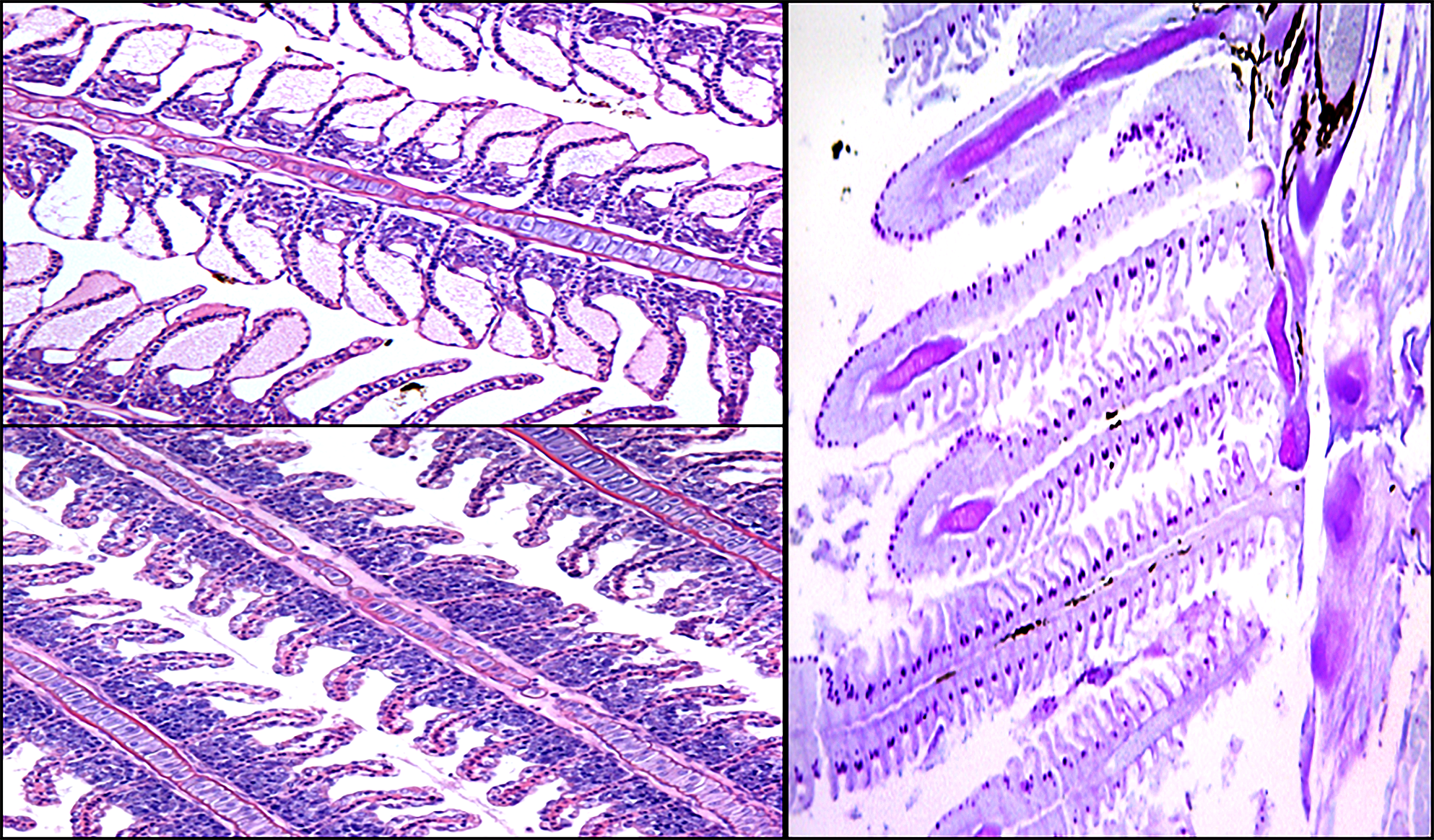In Canada, agriculture and forestry are leading industries in pesticide use.
Currently, at the University of Manitoba, research is being done to investigate the environmental effects of these chemicals.
For the past two years, I have been examining the environmental impacts of polyethoxylated tallow amine (POEA), a surfactant paired with the glyphosate in Roundup herbicide.
The surfactant acts to break down the waxy outer layer of weeds allowing the active ingredient, glyphosate, to then rapidly enter the plant and inhibit the production of essential amino acids.
Most recently, I’ve paid particular attention to the effects POEA has on fish gills.
Water bodies close to pesticide application sites are at risk of contamination by spray drift and runoff.
Shallow ponds are considered to be at greatest risk because they have a lower ability to dilute contaminants and are also rich with life.
As it happens, small fish are key in maintaining a balance as both predator and prey in these ponds.
Monitoring the effects of pesticides on these fish can give insight to long-term impacts of pesticides to the greater aquatic ecosystem.
Their gills have two primary functions: gas exchange (oxygen uptake from the surrounding water) and ion regulation (the uptake of sodium chloride and the excretion of metabolic waste).
Since the gills are one of the first organs exposed to a hazardous substance, any changes at the cellular level can be observed to determine how bad a contaminant really is to the aquatic environment.
There are a number of tests that can determine the toxicity of a substance, but if you actually want to track the effects first hand, then histopathological techniques are your best bet.
Diseased and dying
Histopathology is defined as the study of the structure and function of cells in diseased tissues.
The word is Greek in origin and is a composite of the root words histos “tissues,” pathos “disease or suffering,” and logia “study.”
Histopathology incorporates the use of a microscope to examine sections of tissue for changes to the function of cells, which may not be outwardly visible to the naked eye.
Specialized stains are used to highlight specific tissue structures or cellular components, such as cartilage, connective tissue, carbohydrates, and lipids.
It’s often best to implement a series of histological methods in order to confirm findings.
Having the ability to apply multiple techniques to an experimental sample size that may not be considered statistically sound can add support to otherwise flimsy results.
Applying the techniques
With the help of these techniques, I am currently investigating the histopathological effects of POEA on fathead minnow gills.
Hematoxylin and eosin is one out of two stains that I use in my analysis and the most frequently associated with histopathology.
The hematoxylin stains the nuclei of the cells blue and the eosin counterstains the cytoplasm of the cells pink.
One of the most commonly observed alterations to gills is the increase of cell number and size, known as hyperplasia and hypertrophy.
It’s speculated that this swelling of cells is a mechanism to inhibit the contaminant from entering the fish and to protect internal organs.
The trade off, however, is reduction in gas exchange which seals an unfortunate fate for fish.
In order to measure this, I calculate the percentage of surface area of the gills – the smaller the percentage, the less oxygen uptake.
Another alteration associated with injury of gills is the increase of mucous cells.
It’s not difficult to guess what mucous cells do; they secrete mucus. Mucus production increases in response to the exposure of harmful substances.
This happens to us as well – just think about how much you have to blow your nose when you get sick.
Well, fish have this natural response too, and in order to increase mucus production the number of mucous cells increases.
Since mucous cells are carbohydrate-rich, I use a special stain called Periodic-Acid Schiff, which makes it easy to identify these cells.
Remember, these defences come at a cost. Cell damage in gills reduces ion exchange and impairs respiration.
Exposure to contaminants for long durations or at high concentrations can ultimately lead to fish death.
Luckily, no fish died during my exposure and the preliminary results revealed that though cellular damages are observed early on, they decrease over time.
This indicated that POEA at concentrations estimated in the environment breaks down rapidly in water and does not cause permanent damage to the gills.
This is not to say that the results would be the same in a real-life scenario where POEA may be applied up to five times over a growing season.
The design of my experiment is based only on a one-time, mid-summer herbicide application.
Polyethoxylated tallow amine’s short time in the water column may be good news for fish, but there are many other organisms to consider that live in other niches of aquatic environments – for example, sediment.
Ecosystems are delicately balanced and the slightest offset can cause a cascade of effects.
An organism as insignificant to us as a minnow may have a critical role in the healthy function of the system – remove the minnow and the system collapses.






GMO is a dangerous poison. Eating genetically modified corn (GM corn) and consuming trace levels of Monsanto’s Roundup chemical fertilizer caused rats to develop horrifying tumors, widespread organ damage, and premature death. rats exposed to even the smallest amounts, “developed mammary tumors and severe liver and kidney damage as early as four months in males, and seven months for females.” The animals on the GM diet suffered mammary tumors, as well as severe liver and kidney damage. Everywhere GMO is being grown, food allergies, disorders such as autism, reproductive disorders, digestive problems, and others have been skyrocketing in the human populations.
There has been a drastic decline of crop-pollinating insects all over the world, and what this means for the future of the world’s food supply. Wild pollinators like bumblebees, butterflies, and beetles are basically disappearing. GMO industrial agricultural practices are causing this insect genocide. Pollinating insects in general, which include a wide range of insects and other animals, are simply vanishing from their normal habitats and foraging areas. That lower diversity and lower abundance of wild insects means less fruits and destruction of the diversity of plants and their fruits worldwide.
GMOs cross pollinate and their seeds can travel. It is impossible to fully clean up our contaminated gene pool. Self-propagating GMO pollution will outlast the effects of global warming and nuclear waste. The potential impact is huge, threatening the health of future generations. GMO contamination has also caused economic losses for organic and non-GMO farmers who often struggle to keep their crops pure.
GMOs increase herbicide use. Most GM crops are engineered to be “herbicide tolerant”―surviving deadly weed killers. Monsanto, for example, sells Roundup Ready crops, designed to survive applications of their Roundup herbicide. Between 1996 and 2008, US farmers sprayed an extra 383 million pounds of herbicide on GMOs. Overuse of Roundup results in “superweeds,” resistant to the herbicide. This is causing farmers to use even more toxic herbicides every year. Not only does this create environmental harm, GM foods contain higher residues of toxic herbicides. Roundup, for example, is linked with sterility, hormone disruption, birth defects, and cancer.
GM crops and their associated herbicides can harm birds, insects, amphibians, marine ecosystems, and soil organisms. They reduce bio-diversity, pollute water resources, and are unsustainable. For example, GM crops are eliminating habitat for monarch butterflies, whose populations are down 50% in the US. Roundup herbicide has been shown to cause birth defects in amphibians, embryonic deaths and endocrine disruptions, and organ damage in animals even at very low doses. GM canola has been found growing wild in North Dakota and California, threatening to pass on its herbicide tolerant genes on to weeds.
By mixing genes from totally unrelated species, genetic engineering unleashes a host of unpredictable side effects. Moreover, irrespective of the type of genes that are inserted, the very process of creating a GM plant can result in massive collateral damage that produces new toxins, allergens, carcinogens, and nutritional deficiencies.
GMOs do not increase yields, and work against feeding a hungry world.
Whereas sustainable non-GMO agricultural methods used in developing countries have conclusively resulted in yield increases of 79% and higher, GMOs do not, on average, increase yields at all. This was evident in the Union of Concerned Scientists’ 2009 report Failure to Yield―the definitive study to date on GM crops and yield.
The toxins associated with GMO should never be tolerated. NEONICOTINOID PESTICIDE neurotoxins are absolutely the main factor causing the collapse of bee and pollinator populations along with other lethal chemicals, glysophate, etc. When these poisons are banned as they were in Europe the bee populations start to recover. GMO neonicotinoids, roundup etc. MUST BE BANNED OUTRIGHT and all the farmers along with USDA, Biotech and chemical companies told to cease and desist from what they are doing.
An even scarier prospect: the “BT” version of GMO soybeans and corn, (basically pesticides engineered directly into the plant )
The “BT toxin” gene is put into the DNA of the corn in order for it to manufacture its own toxins that kill pests. The BT gene originated from a soil bacteria that also infiltrates the microflora (friendly digestive bacteria) in your gut. The Bt gene converts the microflora in your intestine into toxin-manufacturing machines.
So, to be clear, eating GMO corn products can cause your gut (which is primarily responsible for keeping you healthy) to turn into a breeding ground for tiny little pesticide factories inside your body, actively creating toxins which are designed to kill living things. These toxins are found in the blood and are readily transferred across the placenta to developing babies in the womb.
But Glyphosate formulations that are to be used near water take that into account. Why didn’t you?
Hi Mark
you have posted this same comment on multiple sites today. Leta look at it:
The rat tumour paper was retracted because it was junk science rejected by food safety authorities around the world.
“Following a review of the published data,scientists from Health Canada and the Canadian Food Inspection Agency (CFIA) have identified significant shortcomings in the study design, implementation and reporting. The methodology used was inadequately described, the full data set was not presented, and the data that was reported was not presented in a transparent manner. Furthermore, the statistical methods used by the authors to analyze the data were judged to be inappropriate. These limitations make the validity of the study results difficult to determine…”
Third time Seralini et al has been caught publishing pseudo-science.
http://www.hc-sc.gc.ca/fn-an/gmf-agm/seralini-eng.php
No health authority in the world has ever found a link between food derived from GE crops and any of those disorders.
if you want to point a finger at pollinator issues look at Vorroa mites, a definite smoking gun. Here is what the experts say about the alleged connection between GE crops and bees:
“Verdict on Bt crops: The specific Bt cry proteins used in GM crops were intentionally chosen to not cause harm to bees. There is no evidence to date that they do. On the other hand, Bt crops require less use of insecticides that are clearly toxic to bees [25].
}Verdict on GM crops in general: Quote from the USDA:
…”there is no correlation between where GM crops are planted
and the pattern ofCCD incidents. Also, GM crops have been widely planted since the late 1990s,but CCD did not appear until 2006. In addition, CCD has been reported in countries that do not allow GM crops to be planted, such as Switzerland “[33].
http://scientificbeekeeping.com/sick-bees-part-18e-colony-collapse-revisited-genetically-modified-plants/
The use of glyphosate has allowed farmers to reduce or eliminate harsher herbicides with higher EIQ’s. I do agree better stewardship is needed for HT crops though.
You need to read some real science on glyphosate:
The BfR has finalised its draft report for the re-evaluation of glyphosate more than 150 new toxicological studies were evaluated for the first time
In addition, all available toxicological studies (nearly 300) were re-assessed about 900 publications from scientific journals have been considered in the draft report and more than 200 publications data were reviewed
in detail
Do not show carcinogenic or mutagenic properties of glyphosate nor that glyphosate is toxic to fertility, reproduction or embryonal/fetal development in laboratory animals.
http://www.bfr.bund.de/en/the_bfr_has_finalised_its_draft_report_for_the_re_evaluation_of_glyphosate-188632.html
Your worries about trangenics have been studied for decades and the global scientific opinion is very different from yours:
A Decade of EU-Funded GMO Research 2001-2010
Food Safety:
“The main conclusion to be drawn from the efforts of more than 130 research projects, covering a period of more than 25 years of research, and involving more than 500 independent research groups, is that biotechnology, and in particular GMOs, are not per se more risky than conventional plant breeding technologies.”
”
“The World Health Organization, the American Medical Association, the U.S. National Academy of Sciences, the British Royal Society, and every other respected organization that has examined the evidence has come to the same conclusion: consuming foods containing ingredients derived from GM crops is no riskier than consuming the same foods containing ingredients from crop plants modified by conventional plant improvement techniques.”
(American Association for the Advancement of Science 2012)
You apparently have little knowledge about Bt or how DNA is digested:
From the OECD Consensus Document on Plants Expressing Insecticidal Proteins:
“Health:
Both the long history of safe use of B. thuringiensis and the acute oral toxicity data allow for a conclusion that these and other δ-endotoxins pose negligible toxicity risk to humans.
Environment:
The overall safety record for Bt has been established in laboratory and field studies, which have looked at both formulated Bt sprays [Organic] and specific Bt genes [GMO]in planta (Betz et al.,2000; Siegel, 2001; Federici, 2002).”
(UN-OECD 2004)